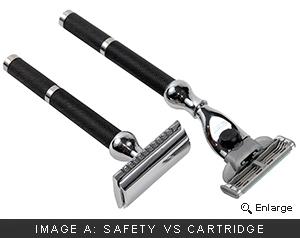
Technology's Curse: The Pivot Head
Despite the growing number of men who have discovered the joy of traditional wetshaving every morning, the fact remains that most men hate shaving and want to get it over with as quickly and as painlessly as possible. Cartridge razors and aerosol cans were created to accomplish this task and make shaving as simple and fool proof as possible for the average user. The pivoting head of modern razors has been marketed as a way to improve the shaving experience by allowing a man to be lazy and ignore angle and pressure. He does not have to pay attention to the angle he holds the razor to his face while moving the blade along the skin. Although the idea sounds great in theory, it is no secret that the cartridge razor design causes skin irritation and is very expensive over the long term (See The Benefits of Traditional Shaving.) Many men are curious to try traditional shaving, but the bad habits they developed from days of using cartridges become painfully clear.
Anatomy of a Cartridge Razor
Most men begin shaving using modern cartridge razors, such as the Mach 3, Quatro, or Fusion, which are available at virtually every grocery and drug store in the country today. Many specialty shaving stores also sell designer handles for these brands (such as the Parker 42M in Image A), but they still use the regular commercial cartridge heads. The pivoting head ensures that the blade remains in contact with the skin regardless of the angle of the razor.
The design of a cartridge also requires that the user applies slight pressure during the shave because the blades are mounted at a steep angle and the blade gaps are tiny. Also, without applying light pressure the pivot head would not follow the contour of the face.
Transitioning from Cartridge to Traditional
The biggest problem many men encounter is that they try to shave with a safety razor as though it were a cartridge razor. Unlike cartridge razors where a slight pressure is required, safety razors can be dangerous if pressure is applied. The goal is to allow the blade to glide smoothly over the skin. Also traditional safety razors are fixed heads that do not have any moving parts or pivoting mechanism. The angle of the blade and contact with the skin is manually controlled by the user. It is critical that a new wetshaver learn how to manipulate the razor across the face in a way that maintains consistent contact with the skin. For example, when shaving from chin to neck the safety razor will not pivot and follow the contours of your face; the user must adjust the angle he holds the handle so that the blade maintains a proper cutting edge the entire time.
In Image B you can see that the razor’s handle is held at a consistent angle, and the pivoting cartridge head moves to keep the blades flat against the glass regardless of the flat or curved surface. Image C illustrates the need to steeply angle the handle of safety razor to keep the blade flat against the glass as the contour changes. The fixed-head of the safety razor does not pivot, so the user must manually manipulate the angle to ensure that he has consistent blade exposure at all times.
A frequent problem is that a wetshaver will glide the safety razor down his neck like a cartridge razor, only instead of the head pivoting to keep contact, the safety razor will become angled perpendicular to the skin, and so the blade will not be against the skin. See Image D. When the user sees remaining hair, he may do another pass and apply more pressure to the skin, which will result in nicks and cuts, rather than simply paying closer attention to the angle of the cutting head to ensure that blade exposure is consistent.
Back to Basics
If you have been wetshaving with a safety razor for a while and noticed that suddenly your shaves leave your skin irritated or less smooth, be sure to focus specifically on angle and pressure. Assuming that your lather is right and you are using the right blade for your skin type, you should enjoy a close and comfortable shave with your safety razor. Remember that your traditional razor is not a pivoting cartridge, so you cannot rely on the lazy habits of years past. Focus on keeping your cutting edge consistent and manually adjust to get the angles right. After mastering these basics, you will have developed new habits that will serve you better for years to come.
RELATED ARTICLES...
How to Hold a Safety Razor
Your First Razor
A Primer on Men’s Skin Care





Leave a comment